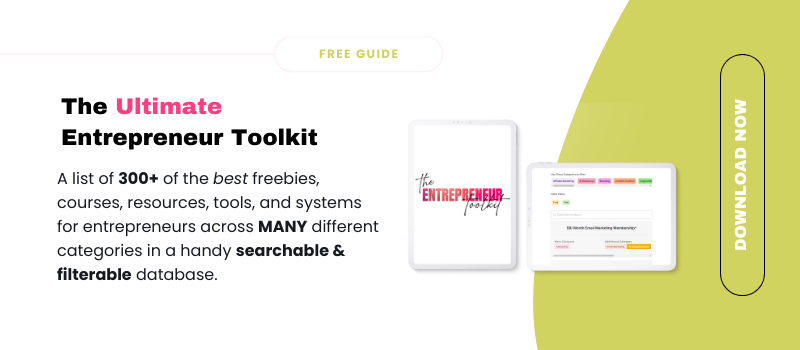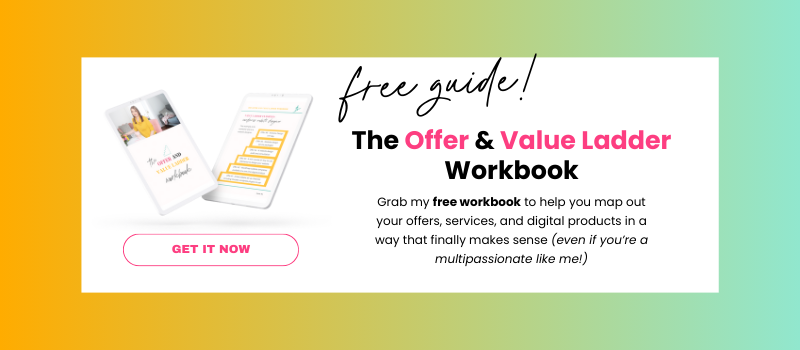Struggling to get the results you want from your emails?
Discover 15 simple yet powerful ways to elevate your email marketing and start seeing real engagement!
Grab your freebie!
Blog Categories
Helping small business owners, virtual assistants, and creative entrepreneurs grow their business.
Hi, I'm Tara! I'm a multi-passionate business and marketing coach.
learn more + get a copy:
Last Updated on October 13, 2025 by Tara Reid
Understanding your audience is the foundation of small business success. Audience research isn’t just a fancy marketing term… it’s a powerful way to make smarter decisions, connect with potential customers, and ultimately drive growth. For course creators, digital product sellers, and service providers trying to grow without relying on social media, this strategy is non-negotiable.
Disclaimer: I earn from qualifying purchases. Some of the links on my website are affiliate links, which means, at no additional cost to you, I will earn a small commission if you click through and make a purchase.
By gathering insights through tools like market research surveys, buyer feedback, and analytics platforms like Fathom and HotJar, you can uncover valuable details about what your audience needs and how they behave. These insights help you fine-tune your messaging, improve your offers, and even optimize your sales pages. If you’re still wondering how audience research fits into your growth plans, this guide offers a deeper dive into why understanding your audience matters so much.
The right research doesn’t just give you data — it gives you clarity. And when you’re clear about your audience, every part of your business benefits. Let’s dig into how you can use these insights to get ahead.
Understanding Audience Research
Getting clear on your audience is one of the smartest moves you can make as a business owner. Audience research goes beyond guessing what your customers might want — it’s about discovering their needs, struggles, and behaviors so you can serve them better. This section breaks down what audience research is and why it’s a critical part of growing your small business.
What is Audience Research?
Audience research is the process of gathering detailed insights about your target customers. It involves figuring out who they are, what they care about, and how they behave — both online and offline. Think of it as peeling back the layers of an onion to get to the core of your customers’ needs and motivations.
This research can involve data from various sources like buyer feedback forms, website analytics, or even simple surveys. For example, platforms like HotJar and Fathom Analytics help you see how visitors interact with your site, while email marketing tools such as Drip reveal trends in subscriber behavior. These tools shine a light on the patterns that help you understand your audience better.
Without audience research, you’re essentially throwing darts in the dark, hoping something sticks. But with the right insights, you can create messaging and products that truly resonate.
Why Is Audience Research Critical?
Let’s face it — your business doesn’t cater to everyone. And that’s perfectly okay. Audience research ensures you’re spending your energy connecting with the people who are most likely to benefit from your offers.
Here’s why it’s such a game-changer:
- Targeted Marketing: Knowing your audience helps you craft specific messages that grab attention and hold it. Why waste time on generic campaigns when you can speak directly to what matters to your ideal customer?
- Improved Product Development: Want to create a course or digital product that sells? First, identify your audience’s pain points. Research helps ensure you’re solving the right problems and meeting actual needs.
- Efficient Resource Allocation: Every small business owner has limited time and money. Audience research means you’re investing in strategies and tools, like the ones in this guide, that make the biggest impact.
- Customer Retention: Understanding what makes your audience tick keeps them coming back. Studies often show that retaining existing customers is more cost-effective than acquiring new ones — and research arms you with the data to do just that.
Think about it this way: audience research is like having a treasure map. Without it, you’re wandering aimlessly. With it, you’ve got clear directions to the gold — aka loyal customers and increased sales.
By integrating insights from tools, surveys, and even customer conversations, you’re building a business that’s not just guessing but growing strategically.
Research isn’t just a one-time activity, either. It’s a practice that evolves as your business grows. So, if you’re serious about connecting with the right people and scaling efficiently, audience research is non-negotiable.
Benefits of Audience Research for Small Business Owners
When you’re running a small business, understanding your audience isn’t just helpful — it’s essential. It’s the shortcut to figuring out what your customers want and how you can give it to them. By focusing on audience research, you’re not just improving your marketing; you’re building a business that solves real problems and meets specific needs.
Let’s break down why this strategy matters so much, starting with how it impacts your growth and decision-making.
Identifying Target Demographics
You can’t sell to everyone — and you shouldn’t try. Audience research helps you pinpoint who your ideal customers are and identifies patterns in their behavior. Whether it’s demographic data, interests, or buying habits, this information gives you clarity. For example, tools like surveys, email feedback forms, and platforms such as Drip can reveal essential details about who’s engaging with your brand.
Think of it like detective work. You’re gathering clues about your audience — what keeps them up at night, what excites them, and how they prefer to shop. With clear insights, you can focus your resources on customers who are already likely to buy from you rather than wasting time on a broad, unfocused approach.
Improving Product Offerings
Let’s be real — guessing what your audience wants is like throwing spaghetti at the wall and hoping something sticks. Instead, audience research gives you data to create products and services tailored to their actual needs. For example, analyzing traffic data using tools like Fathom or behavioral feedback from HotJar can identify where users drop off on your sales page or which features they engage with most.
When you know your audience deeply, you can refine your offers. Imagine getting buyer feedback that reveals a key feature your product lacks or spotting trends from your email subscribers that spark new digital product ideas. These are golden opportunities to adjust and grow your offerings in ways that truly resonate.
If you’re just starting, this audience research guide can provide actionable tips to hit the ground running.
Crafting Tailored Marketing Strategies
Ever feel like your marketing is missing the mark? It’s probably because you’re speaking to “everyone” instead of your ideal customer. Insightful audience research helps you craft personalized strategies that feel like a one-on-one conversation. Email campaigns, blog content, or opt-ins? All of this becomes more precise when you know your audience inside and out.
Note that I’m NOT talking about niching down. I’m talking about being specific in your messaging, using data and insights to segment your audience, and speak to them about different offers. Not niching down your entire business!
For instance, I’ve noticed that understanding where my customers hang out online shapes everything from the tone of my emails to the timing of my outreach. If your audience prefers text over videos, you’ll know to spend time crafting better email messages instead of jumping on the latest video trend.
Need help with storytelling in your marketing copy? Check out this helpful guide.
In short, knowing your audience lets you connect with the right people, in the right way, at the right time. It’s like having a roadmap to engagement. Once you have their attention, the next step—turning them into loyal customers — is so much easier.
Audience research isn’t an extra step; it’s the piece that makes everything else work better. By identifying who your customers are, improving what you offer, and fine-tuning how you communicate, you’ll save time, money, and resources while setting yourself up for long-term success. If you’re looking for more ways to fine-tune your strategy, consider diving deeper into the possibilities with additional audience research tips here.
Tools and Resources for Conducting Audience Research
Understanding your audience starts with using the right tools and resources. These tools not only make data collection easier but also help you uncover insights that can transform your business strategy. Here’s how you can leverage different techniques and platforms to dive deeper into your audience’s needs.

Market Research Surveys
Surveys are one of the simplest yet most effective ways to gather valuable insights. By asking the right questions, you can understand your audience’s preferences, challenges, and expectations. Platforms like Google Forms or Typeform make it easy to create surveys that are quick to complete. The key is to focus on clarity — short, specific questions yield the best results.
Why are surveys powerful? They let you hear directly from your audience in their own words. For example, if you’re a course creator, asking about topics your audience struggles with most can identify the gaps your next course could fill. And don’t forget to incentivize participation — a discount or freebie can dramatically increase responses. For more tips on creating highly engaging surveys, check out how audience data drives smarter decisions.
Analyzing Non-Buyer Emails
Not every lead turns into a buyer, but that doesn’t mean their input isn’t valuable. Analyzing non-buyer emails can help answer critical questions: Did your pitch miss the mark? Was there confusion about your offer? Or was there simply a timing issue?
I’ve found that non-buyers often share the most honest feedback — they’re not worried about sparing your feelings. Keep an eye out for recurring themes like pricing concerns or unclear messaging. By addressing these, you can refine future offers and lower your bounce rates. Tools like Drip can help you track email interaction and responses effectively, giving you a direct line to understanding the “why” behind their decisions.
Collecting Buyer Feedback Forms
Your best source of input often comes straight from your buyers. Feedback forms sent post-purchase can help you pinpoint what worked and what didn’t. Ask open-ended questions like “What made you choose this product?” or “What almost stopped you from buying?” Their answers often uncover hidden trends.
Feedback isn’t just about improving products — it boosts trust and loyalty. When customers see you actively care about their experience, they’re more likely to recommend you to others. It’s another small effort that pays big dividends.
Email Marketing Insights with Drip
As an email marketing platform, Drip offers unique insights into how your subscribers interact with your content. By analyzing open rates, click-throughs, and behavior flows, you can see what’s resonating — and what’s not.
For instance, if you notice certain email campaigns consistently outperform others, dig deeper. Look at the subject lines, content structure, and timing. Replicating these patterns helps you maintain interest and engagement across new campaigns. Curious about tailoring your messaging? Learn more about how to write content that connects here.
Analyzing Traffic with Fathom Analytics
If website performance feels like a mystery, Fathom Analytics provides easy-to-understand data. Unlike heavy, overwhelming platforms, Fathom focuses on simplicity. You’ll learn where your traffic is coming from, pages with the most engagement, and where people drop off.
Let’s say one of your blog posts is getting a lot of hits but low conversions. Fathom can show you where users spend their time and where they bounce. With these insights, you might tweak your call-to-action or add more value to retain visitors longer.
Utilizing HotJar for Sales Page Actions
Your website is often the first impression, especially for sales pages. Tools like HotJar let you see exactly how visitors interact with your pages. From click maps to user session recordings, you can track what’s working and what’s not.
For example, if users don’t scroll down to your pricing section or ignore your call-to-action, these are signs you need to rethink your layout or placement. Tracking behaviors helps turn casual visitors into paying customers.
Keyword Research for Audience Understanding
Keyword research isn’t just for SEO — it’s a window into what your audience is actually searching for. Tools like Google Keyword Planner, SEMrush, Keysearch, Keywords Everywhere, or Ubersuggest highlight trends, questions, and popular search terms in your niche. This data helps you create products and content that align with audience interests.
For example, if you find people frequently searching “how to make passive income with digital products,” you know there’s a demand for this topic. Your next step could be building a comprehensive course or blog series targeting this interest.

By combining these tools and strategies, you’ll build a clear picture of your audience in no time. These insights are the foundation for smarter business decisions, higher conversions, and lasting customer loyalty.
Implementing Results from Audience Research
So, you’ve done the hard work of conducting audience research, and now you’re sitting on a goldmine of insights. But what’s next? Research is only as valuable as the actions you take based on it. Whether you’re refining your marketing strategies or brainstorming your next big product idea, implementing these findings is where real growth happens.
Adapting Marketing Strategies Based on Research
Marketing without a clear audience is like throwing darts blindfolded — you might hit the target, but it’s mostly luck. With audience insights in hand, you can adapt your strategies to connect more effectively. If you’re a multi-passionate (like me!) I suggest using the Value Ladder format so you can get super clear on the audience for each offer or product.

Here’s how:
- Personalize Your Messaging: If your audience research reveals what matters most to your customers, use that to craft messages that resonate. For example, if you know your audience values convenience, highlight that in your emails, product descriptions, and even ad campaigns.
- Choose the Right Platforms: Your audience research may show where your ideal clients are spending their time online. Stop wasting effort on platforms they don’t use and double down where they are active.
- Refine Your Offers: Test variations of your headlines, call-to-actions, or even pricing structure based on what you’ve learned. Tools like HotJar provide insights into what grabs your audience’s attention on your sales pages, allowing you to tweak for maximum impact.
Audience research doesn’t just tell you what to do — it shows you where to focus for the biggest returns. Marketing becomes far more efficient and effective when it’s tailored to the precise needs of your target audience.
Innovating Products and Services
Ever launched a product you were excited about, only to have it fall flat? Audience research can prevent that by giving you a clear understanding of what your audience truly needs.
- Feedback-Driven Development: Use input from surveys, buyer feedback forms, or even non-buyer emails to guide product tweaks or updates. If customers frequently mention a missing feature, that’s your sign to add it.
- Spot Emerging Trends: Sometimes, research uncovers new opportunities you hadn’t considered. Maybe keyword research shows a growing interest in eco-friendly packaging, or survey responses highlight a demand for tech-free wellness courses. These trends can inform your next steps.
- Create Tiered Offerings: Not all of your audience members want or need the same thing. Your research might show that some customers prefer premium options while others are happy with stripped-down basics. Offering tiers lets you meet different customers where they’re at while maximizing revenue.
For instance, if you notice consistent traffic to a specific blog topic that wasn’t tied to an existing product, it might be worth expanding on that topic. Look into traffic data using tools like Fathom Analytics to confirm your next move.
When your products and services align with your audience’s needs, you’re not just building for the sake of it — you’re solving real problems and building loyalty.
By using what you’ve learned, whether to refine marketing or innovate boldly, your research becomes a practical tool for scaling your business effectively. Stay tuned for more strategies in the next section.
Common Mistakes to Avoid in Audience Research
Audience research is every small business owner’s secret weapon, but only if it’s done right. If you’re not careful, simple missteps can lead to wasted time, skewed data, and poor decision-making. Let’s shine a light on some common pitfalls so you can avoid them and keep your research sharp.
Ignoring Data Trends
Trends in audience data are like signals pointing you toward what’s working (and what’s not). Ignoring these markers is like driving blindfolded — it’s bound to end in a crash. Whether it’s website traffic, engagement levels, or purchasing habits, these trends give you direction.
It’s tempting to focus only on broad averages or one-time results. But trends show the bigger picture — patterns over time that help you understand shifts in your audience’s needs and preferences. For instance, if your sales page sees gradual drops in conversions, tools like HotJar can help identify where users disengage.
When you skip trend analysis, you miss out on insights that could refine your approach. Are people shifting toward mobile purchases? Is a specific product category trending up? Pay attention to the numbers — they don’t lie.
Relying Solely on Assumptions
Assumptions can be dangerous. They’re like playing darts with your eyes closed — sure, sometimes you hit the target, but mostly you miss. Too many business owners base strategies on what they think they know about their audience instead of real data.
Instead, gather data first. Use tools like Drip to analyze email subscriber behavior or surveys to collect direct feedback. Don’t rely on gut feelings when you can make informed decisions based on hard evidence. You’d be surprised how often data contradicts assumptions. To dive deeper into creating solid strategies, check out these marketing insights.
Underestimating the Importance of Segmentation
Throwing everyone in one big audience bucket? That’s like mailing invitations to a party without directions. Audience segmentation isn’t optional — it’s critical for reaching the right people with the right message.
What works for one segment of your audience might completely turn off another. Let’s say you’re a course creator. Your audience might include beginner entrepreneurs and seasoned business owners. Both groups likely have different pain points and goals. Addressing both in the same email or sales pitch dilutes your messaging.
Segmenting helps you get specific. Use tools like Fathom Analytics to inspect traffic behaviors and identify distinct audience groups. Then, tailor your marketing efforts. For example, offering advanced strategies to experienced entrepreneurs while focusing on foundational tips for newcomers.
Skipping segmentation is a missed opportunity to personalize your marketing and build deeper connections. Remember, people respond best when they feel directly understood and spoken to.
By steering clear of these common missteps, you’ll make your audience research work harder for you. Thoughtful data analysis, leaving assumptions behind, and prioritizing segmentation will ensure you make smarter, more impactful business decisions.
Conclusion
Audience research is the cornerstone of successful small business growth. By understanding your customers’ needs, challenges, and behaviors, you’re not just marketing — you’re connecting. When done right, audience research can transform everything from your messaging to your product offerings, all while saving time and money.
The insights you gather should always fuel action. Use them to create content that resonates, refine your offers, and improve your customer experience. The more you know your audience, the better you can serve them. Ultimately, this is what builds trust, loyalty, and long-lasting success.
For small business owners, tools like market research surveys and platforms like Fathom Analytics become essential. They allow you to dig deeper into your audience’s preferences, giving you the clarity to move from guessing to knowing.
Tara Reid is a multi-passionate business and marketing strategist for introverted entrepreneurs who want to grow without relying on hustle culture or social media. With 18+ years of online business experience, she helps course creators, service providers, and digital product sellers build sustainable businesses through evergreen marketing, blogging, SEO, Pinterest, and email.
As the founder of the Introvertpreneur Club, Tara’s mission is to show heart-centered entrepreneurs that you don’t have to be loud to be successful. You just need the right strategies that fit your personality.
When she’s not supporting clients or creating new resources, you can find her at home in Canada with her three rescue dogs, a cup of coffee in hand, dreaming up her next project.
The Introvertpreneur Podcast
listen in to the top rated business podcast that is designed for introverted entrepreneurs who want to grow + scale in a more sustainable and fun way!
Top rated podcast
This one's on me. Complimentary free stuff coming right up.
leaving so soon?
Look behind the curtain and see exactly what I do every week, month, and quarter, to market my business without social media (in under 5 hours per week)!
The Quiet Marketing Playbook
Take this free quiz and learn what your superpower is as an entrepreneur. You'll also get a curated list of my best resources and tips for using your superpower to your advantage!
What's your Introverted Superpower?
Best Free Resources:
dig into 'em now!
A business strategist and marketing coach who focuses on helping course creators, coaches, and service providers, build sustainable businesses without social media.
